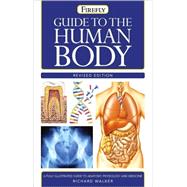
Richard Walker is an award-winning author on human biology and has written Encyclopedia of the Human Body and Genes and DNA. In 2002, he won the Aventis Prize for Science Books, Junior Prize.
| DNA and proteins Body organization tissue, organs, systems | |
| Integumentary system skin, hair, nails Skeletal system skeleton bone skull backbone shoulder and arm hip and leg joints | |
| Muscular system muscles muscles and movement muscle contraction | |
| Nervous system neurons and synapses brain spinal cord nerves autonomic nervous system touch and pain taste and smell eyes and vision ears, hearing and balance | |
| Endocrine system endocrine glands and hormones pituitary gland | |
| Cardiovascular system circulation heart blood blood vessels | |
| Lymphatic system lymph and organs | |
| Immune system lymphocytes and antibodies | |
| Respiratory system airways lungs and gas exchange breathing larynx and speech | |
| Digestive system food and nutrition chewing and swallowing stomach small intestine and pancreas large intestine liver and metabolism kidneys | |
| Urinary system bladder and urination | |
| Reproductive system male female fertilization and implantation pregnancy childbirth growth and development genes and inheritance | |
| Medical Encyclopedia Over 600 concise definitions of medical conditions and terminology | |
| Index | |
| Table of Contents provided by Publisher. All Rights Reserved. |
The New copy of this book will include any supplemental materials advertised. Please check the title of the book to determine if it should include any access cards, study guides, lab manuals, CDs, etc.
The Used, Rental and eBook copies of this book are not guaranteed to include any supplemental materials. Typically, only the book itself is included. This is true even if the title states it includes any access cards, study guides, lab manuals, CDs, etc.
The human body is a living structure of incredible complexity. The purpose of this book is to describe simply yet comprehensively the anatomy (structure), physiology (function), and interdependence of the body's component parts. Throughout the book, for ease of description, specific terms are used to describe different regions of the body, and the orientation and position of the body parts. This terminology, in common usage by doctors and scientists, is explained below.
When viewed externally, the whole body is divided into regions and areas. The head houses the brain and major sense organs. It is supported and protected by the skull, which also forms the framework of the face. The head is held upright by the muscles and bones of the neck, which connects the head to the trunk. The trunk (or torso) forms the central part of the body and has two sections: the thorax forms the upper part of the trunk and extends from the neck to the diaphragm. The diaphragm is a sheet of muscle that separates the thorax from the abdomen, the lower part of the trunk. The terms cephalic, cervical, thoracic, and abdominal describe items found respectively, in the head, neck, thorax, or abdomen. The two upper limbs (or extremities) are each divided into three regions: the arm, forearm, and hand; the hollow just beneath the junction between the upper extremity and trunk is the axilla (or armpit). The two lower limbs (or extremities) are divided into the thigh, leg, and foot. Most organs, such as the heart and stomach, are enclosed inside one of three closed cavities within the body. Females and males have the same body regions, but their body shapes, and internal and external reproductive organs, differ.
The terminology that describes orientation and direction assumes that the body is upright, with arms at the side, and the palms facing forward. Some terms refer to an imaginary midline, or axis, that runs vertically down the center of the body and splits it in two.
Medial means at or near to the midline, or on the inner side of it; lateral means away from the midline, or on the outer side of it. For example, the backbone is medial to the kidneys; the left eye is lateral to the bridge of the nose.
Superior means above, or towards the head or upper parts of the body; inferior means below, or towards the lower part of the body. For example, the superior vena cava is a large vein that carries blood into the heart from the upper body; the inferior vena cava does the same from the lower body.
Anterior (ventral) means towards the front of the body; posterior (dorsal) means toward the back of the body. For example, the heart is anterior to the backbone; the sacrum is posterior to the urinary bladder.
Proximal refers to something that is nearer to the point of attachment of a body part; distal means further away. The proximal end of a digit in the hand is at the knuckle, while its distal end is at the fingertip.
Superficial is used to indicate something at or near the body's surface; deep means located away from the body's surface. For instance, the skin is superficial to the skeleton, while the brain is deep to the skull.
Excerpted from Guide to the Human Body by Richard Walker
All rights reserved by the original copyright owners. Excerpts are provided for display purposes only and may not be reproduced, reprinted or distributed without the written permission of the publisher.